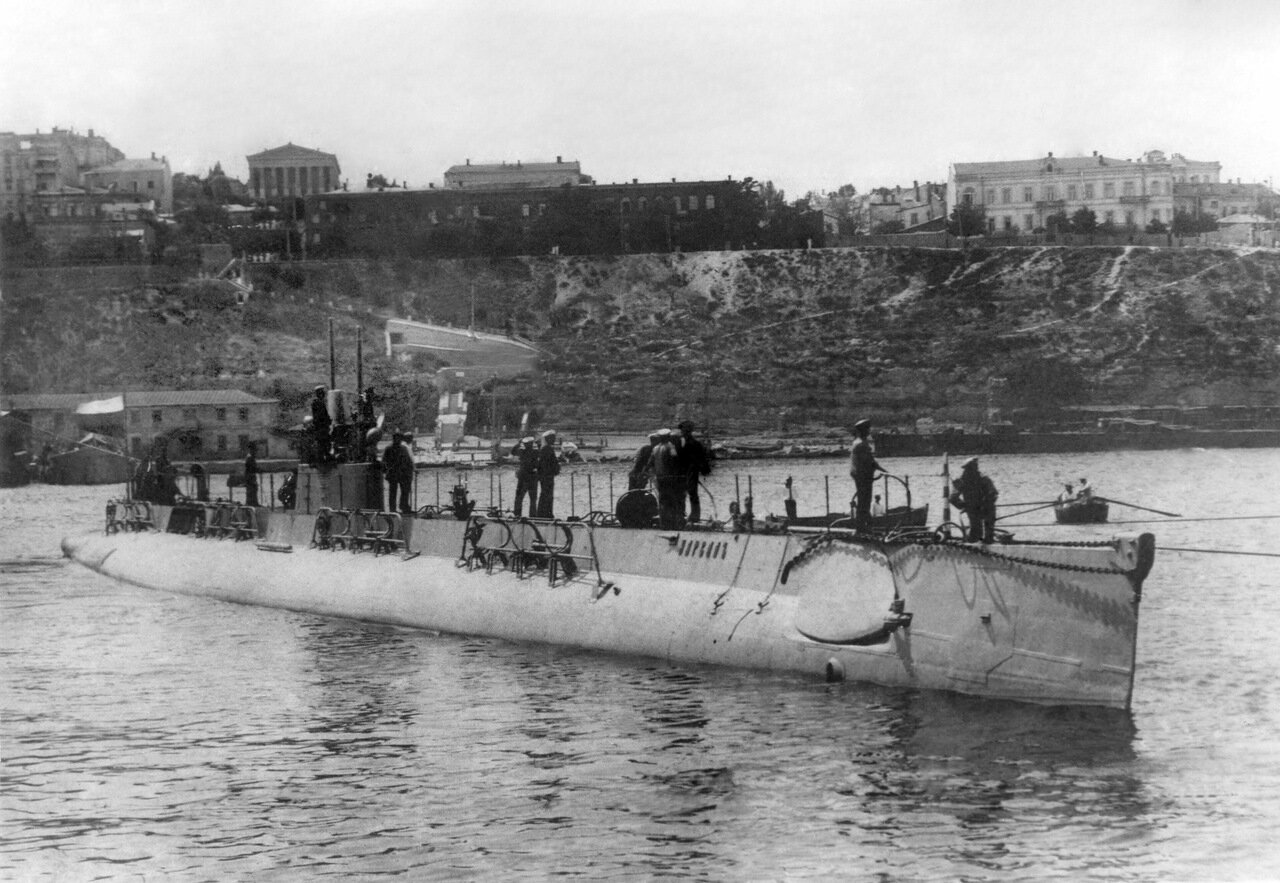|
Russian Narval-class Submarine
The ''Narval'' class were a group of submarines built for the Imperial Russian Navy. They were designed by the Electric Boat Company and ordered in the 1911 programme as the "Holland 31A" design. The Narval class had advanced features including watertight bulkheads, a crash diving tank and gravitationally filled ballast tanks which did not feature in contemporary Russian-designed boats. The boats were well regarded by the Russian Navy and served in the Black Sea Fleet during World War I, during which they sank 8 merchant ships and 74 coastal vessels. At the end of 1917, the submarines were transferred to the reserve. The submarines were scuttled by British forces in April 1919 near Sevastopol. Ships Three submarines were built by Nikolayev Dockyard. ''Kit'' was raised by EPRON in 1934, but the hulls of the other two boats remain on the bottom in the place they were scuttled. The whereabouts of ''Narval'' was unknown until October 2014, though some historians believe it was ... [...More Info...] [...Related Items...] OR: [Wikipedia] [Google] [Baidu] |
Submarine
A submarine (or sub) is a watercraft capable of independent operation underwater. It differs from a submersible, which has more limited underwater capability. The term is also sometimes used historically or colloquially to refer to remotely operated vehicles and Autonomous underwater vehicle, robots, as well as medium-sized or smaller vessels, such as the midget submarine and the wet sub. Submarines are referred to as ''boats'' rather than ''ships'' irrespective of their size. Although experimental submarines had been built earlier, submarine design took off during the 19th century, and they were adopted by several navies. They were first widely used during World War I (1914–1918), and are now used in many navy, navies, large and small. Military uses include attacking enemy surface ships (merchant and military) or other submarines, and for aircraft carrier protection, Blockade runner, blockade running, Ballistic missile submarine, nuclear deterrence, reconnaissance, conventio ... [...More Info...] [...Related Items...] OR: [Wikipedia] [Google] [Baidu] |
Whale
Whales are a widely distributed and diverse group of fully aquatic placental marine mammals. As an informal and colloquial grouping, they correspond to large members of the infraorder Cetacea, i.e. all cetaceans apart from dolphins and porpoises. Dolphins and porpoises may be considered whales from a formal, cladistic perspective. Whales, dolphins and porpoises belong to the order Cetartiodactyla, which consists of even-toed ungulates. Their closest non-cetacean living relatives are the hippopotamuses, from which they and other cetaceans diverged about 54 million years ago. The two parvorders of whales, baleen whales (Mysticeti) and toothed whales (Odontoceti), are thought to have had their last common ancestor around 34 million years ago. Mysticetes include four extant (living) families: Balaenopteridae (the rorquals), Balaenidae (right whales), Cetotheriidae (the pygmy right whale), and Eschrichtiidae (the grey whale). Odontocetes include the Monodontidae (beluga ... [...More Info...] [...Related Items...] OR: [Wikipedia] [Google] [Baidu] |
Submarine Classes
A submarine (or sub) is a watercraft capable of independent operation underwater. It differs from a submersible, which has more limited underwater capability. The term is also sometimes used historically or colloquially to refer to remotely operated vehicles and robots, as well as medium-sized or smaller vessels, such as the midget submarine and the wet sub. Submarines are referred to as ''boats'' rather than ''ships'' irrespective of their size. Although experimental submarines had been built earlier, submarine design took off during the 19th century, and they were adopted by several navies. They were first widely used during World War I (1914–1918), and are now used in many navies, large and small. Military uses include attacking enemy surface ships (merchant and military) or other submarines, and for aircraft carrier protection, blockade running, nuclear deterrence, reconnaissance, conventional land attack (for example, using a cruise missile), and covert insertion of ... [...More Info...] [...Related Items...] OR: [Wikipedia] [Google] [Baidu] |
Remotely Operated Underwater Vehicle
A remotely operated underwater vehicle (technically ROUV or just ROV) is a tethered underwater mobile device, commonly called ''underwater robot''. Definition This meaning is different from remote control vehicles operating on land or in the air. ROVs are unoccupied, usually highly maneuverable, and operated by a crew either aboard a vessel/floating platform or on proximate land. They are common in deepwater industries such as offshore hydrocarbon extraction. They are linked to a host ship by a neutrally buoyant tether or, often when working in rough conditions or in deeper water, a load-carrying umbilical cable is used along with a tether management system (TMS). The TMS is either a garage-like device which contains the ROV during lowering through the splash zone or, on larger work-class ROVs, a separate assembly which sits on top of the ROV. The purpose of the TMS is to lengthen and shorten the tether so the effect of cable drag where there are underwater currents is minimize ... [...More Info...] [...Related Items...] OR: [Wikipedia] [Google] [Baidu] |
Sevastopol National Technical University
Sevastopol State University (formerly Sevastopol National Technical University (SevNTU), Sevastopol Instrument Engineering Institute (SIEI)) is a university in Sevastopol, Crimea. History Sevastopol Instrument Engineering Institute was founded in 1951 as a Sevastopol branch of Nikolayev Shipbuilding Institute (order of the Minister of Higher Education of the USSR No. 489 of 9 October 1951). In June 1960, a Sevastopol branch of Odessa Polytechnic Institute (SB OPI) was created by Resolution of the Council of Ministers of the Ukrainian SSR No. 968 on the basis of the Sevastopol branch of NSI. A significant event for Sevastopol and the recognition of the contribution of the research and educational staff became the opening at the end of 1963 by Resolution of the Council of Ministers of the USSR No. 1222 on the basis of SB OPI of Sevastopol Instrument Engineering Institute (SIEI) consisting of eight Departments: Instrument Engineering Techniques and Fine Mechanics; Radioelectroni ... [...More Info...] [...Related Items...] OR: [Wikipedia] [Google] [Baidu] |
Ministry Of Defence (Russia)
The Ministry of Defence of the Russian Federation (russian: Министерство обороны Российской Федерации, Минобороны России, informally abbreviated as МО, МО РФ or Minoboron) is the governing body of the Russian Armed Forces. The President of Russia is the Commander-in-Chief of the Armed Forces of the Russian Federation and directs the activity of the Ministry. The Defence Minister exercises day-to-day administrative and operational authority over the armed forces. The General Staff executes the president's and the defence minister's instructions and orders. The main building of the ministry, built in the 1940s, is located on Arbatskaya Square, near Arbat Street. Other buildings of the ministry are located throughout the city of Moscow. The supreme body responsible for the Ministry's management and supervision of the Armed Forces is The National Defense Management Center (Национальный центр управ ... [...More Info...] [...Related Items...] OR: [Wikipedia] [Google] [Baidu] |
Russian Geographical Society
The Russian Geographical Society (russian: Ру́сское географи́ческое о́бщество «РГО»), or RGO, is a learned society based in Saint Petersburg, Russia. It promotes geography, exploration and nature protection with research programs in fields including oceanography, ethnography, ecology and statistics. History Imperial Geographical Society The society was founded in Saint Petersburg, Russia on 6 (18) August 1845. Prior to the Russian Revolution of 1917, it was known as the Imperial Russian Geographical Society. The order to establish the society came directly from Emperor Nicholas I. The motive for the establishment was to encourage geographical research on domestic topics, which has later been described as a Russian nationalist political goal. The filial societies were established at the Caucasus (1850), Irkutsk (1851), Vilnius (1867), Orenburg (1868), Kiev (1873), Omsk (1877), and other cities. The Society organized and funded the expediti ... [...More Info...] [...Related Items...] OR: [Wikipedia] [Google] [Baidu] |
EPRON
EPRON, russian: Экспедиция подводных работ особого назначения (ЭПРОН) "Special Expedition for Underwater Works" —Special-Purpose Underwater Rescue Party, was a government agency of the Soviet Union to salvage valuable cargo and equipment from sunken ships and submarines. History EPRON was established on 17 December 1923 and was initially under the Joint State Political Directorate () at the Council of People's Commissars. Its first operation was treasure-hunting near Sevastopol for the wreckage of HMS Prince, a steamship sunk by a storm off Balaklava in November 1854 when it was carrying gold from Britain to pay British troops fighting in the Crimea (GBP 200,000). The project team was financed, equipped, trained and managed by Japanese diving specialists, who had become highly experienced through salvaging warships of the Russian Imperial Navy sunk or scuttled during the 1904–1905 Russo-Japanese War. The wreckage was allegedly lo ... [...More Info...] [...Related Items...] OR: [Wikipedia] [Google] [Baidu] |
Sperm Whale
The sperm whale or cachalot (''Physeter macrocephalus'') is the largest of the toothed whales and the largest toothed predator. It is the only living member of the genus ''Physeter'' and one of three extant species in the sperm whale family, along with the pygmy sperm whale and dwarf sperm whale of the genus ''Kogia''. The sperm whale is a pelagic mammal with a worldwide range, and will migrate seasonally for feeding and breeding. Females and young males live together in groups, while mature males (bulls) live solitary lives outside of the mating season. The females cooperate to protect and nurse their young. Females give birth every four to twenty years, and care for the calves for more than a decade. A mature sperm whale has few natural predators, although calves and weakened adults are sometimes killed by pods of killer whales (orcas). Mature males average in length, with the head representing up to one-third of the animal's length. Plunging to , it is the third deep ... [...More Info...] [...Related Items...] OR: [Wikipedia] [Google] [Baidu] |
Narwhal
The narwhal, also known as a narwhale (''Monodon monoceros''), is a medium-sized toothed whale that possesses a large "tusk" from a protruding canine tooth. It lives year-round in the Arctic waters around Greenland, Canada and Russia. It is one of two living species of whale in the family Monodontidae, along with the beluga whale, and the only species in the genus ''Monodon''. The narwhal males are distinguished by a long, straight, helical tusk, which is an elongated upper left canine. The narwhal was one of many species described by Carl Linnaeus in his publication ''Systema Naturae'' in 1758. Like the beluga, narwhals are medium-sized whales. For both sexes, excluding the male's tusk, the total body size can range from ; the males are slightly larger than the females. The average weight of an adult narwhal is . At around 11 to 13 years old, the males become sexually mature; females become sexually mature at about 5 to 8 years old. Narwhals do not have a dorsal fin and thei ... [...More Info...] [...Related Items...] OR: [Wikipedia] [Google] [Baidu] |
Torpedo Tube
A torpedo tube is a cylindrical device for launching torpedoes. There are two main types of torpedo tube: underwater tubes fitted to submarines and some surface ships, and deck-mounted units (also referred to as torpedo launchers) installed aboard surface vessels. Deck-mounted torpedo launchers are usually designed for a specific type of torpedo, while submarine torpedo tubes are general-purpose launchers, and are often also capable of deploying naval mine, mines and cruise missiles. Most modern launchers are standardized on a diameter for light torpedoes (deck mounted aboard ship) or a diameter for heavy torpedoes (underwater tubes), although other sizes of torpedo tube have been used: see Torpedo#Classes and diameters, Torpedo classes and diameters. Submarine torpedo tube A submarine torpedo tube is a more complex mechanism than a torpedo tube on a surface ship, because the tube has to accomplish the function of moving the torpedo from the normal atmospheric pressure within t ... [...More Info...] [...Related Items...] OR: [Wikipedia] [Google] [Baidu] |






